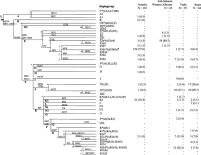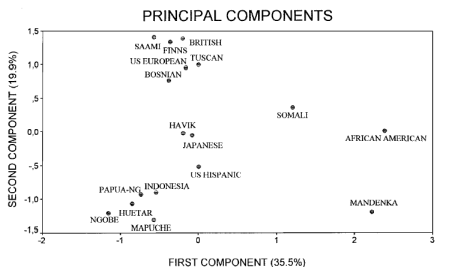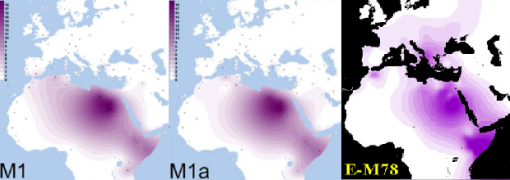Just another WordPress.com weblog
High frequencies of Y chromosome lineages characterized by E3b1, DYS19-11, DYS392-12 in Somali malesAnd a little extra detail…
We genotyped 45 biallelic markers and 11 STR systems on the Y chromosome in 201 male Somalis. In addition, 65 sub-Saharan Western Africans, 59 Turks and 64 Iraqis were typed for the biallelic Y chromosome markers. In Somalis, 14 Y chromosome haplogroups were identified including E3b1 (77.6%) and K2 (10.4%).The haplogroup E3b1 with the rare DYS19-11 allele (also called the E3b1 cluster ) was found in 75.1% of male Somalis, and 70.6% of Somali Y chromosomes were E3b1, DYS19-11, DYS392-12, DYS437-14, DYS438-11 and DYS393-13. The haplotype diversity of eight Y-STRs (‘minimal haplotype’) was 0.9575 compared to an average of 0.9974 and 0.9996 in European and Asian populations. In sub-Saharan Western Africans, only four haplogroups were identified. The West African clade E3a was found in 89.2% of the samples and the haplogroup E3b1 was not observed. In Turks, 12 haplogroups were found including J2*(xJ2f2) (27.1%), R1b3*(xR1b3d, R1b3f) (20.3%), E3b3 and R1a1*(xR1a1b) (both 11.9%). In Iraqis, 12 haplogroups were identified including J2*(xJ2f2) (29.7%) and J*(xJ2) (26.6%). The data suggest that the male Somali population is a branch of the East African population – closely related to the Oromos in Ethiopia and North Kenya – with predominant E3b1 cluster lineages that were introduced into the Somali population 4000–5000 years ago, and that the Somali male population has approximately 15% Y chromosomes from Eurasia and approximately 5% from sub-Saharan Africa.
In Somali males, 14 haplogroups were identified. The frequency of the clade E3b was 81.1%, including 77.6% of the haplogroup E3b1 defined by the M78 mutation. The Eurasian haplogroup K2 was found in 10.4%, and 3.0% of the Somali Y chromosomes belonged to the major clade J. Only 3.0% of the Somalis had the sub-Saharan African haplogroups A3, B and E3a*(xE3a4). Less than 2.0% of the Somalis belonged to the Northwest African E3b2 lineage. In the present study, no individual belonging to E3b* chromosomes carried the V6 mutation, which identifies a subset of chromosomes assigned to E3b* (E-M35

Mt DNA info on Somalia.
Analysis of mtDNA HVRII in several human populations using an immobilised SSO probe
hybridisation assay
Our Somali sample presents features that clearly locate it close to the African samples, but European features are also evident…. For a simple approach to measure the Caucasoid influence in East Africa, the triangle method described by Cavalli-Sforza et al was used to compute the proportion of admixture from the genetic distance matrix. Taking the British as a representative Caucasoid sample and the Mandenka as a sub-Saharan population, the proportion m of caucasoid lineages in the Somali is m = 0.46. (46%) This value is similar to the estimate based on autosomal studies (m = 0.40), and clearly higher than the estimates for the mtDNA found in Ethiopians 1 (m = 0.05–0.27)

The autosomal studies show that as a whole Somalis are about 40% Eurasian, which is about the same as Ethiopians. The maternal DNA is about 20% M1.
This shows a population movement from the Egypt/Nubia area to Somalia starting about 24,000 years ago.

The M78 mutation (y chromosome) that is present in East Africans occurred in North East Africa, not East Africa, and it occurred in a mixed Eurasian/African population.
This expansion was most likely from the Lower Nubia area, and might explain why Somalis show some similarities to the ancient upper Egyptians (Badarians); as their ancestry comes fromthe same region, and they are less influenced by later migrations from Arabia and west Africa. The hg’s involved ( M78/E3b1 and M1/M1a) are shown below, showing a clear focus and origin in Southern modern Egypt (Lower Nubia), expanding into Somalia .

Diagram; “Clines and Clusters Versus Race“, C. Loring Brace. Showing skull similarities in Somalians and predynastic upper Egyptians (lower Egyptians are much more like modern North Africans). The PD Upper Egyptians are just outside the range of modern North Africans, and Somalians show a fairly close relationship to them; unsurprisingly, as a fairly large portion of Somali ancestry seems to come from the Upper Egypt/Nubia area.

No comments:
Post a Comment